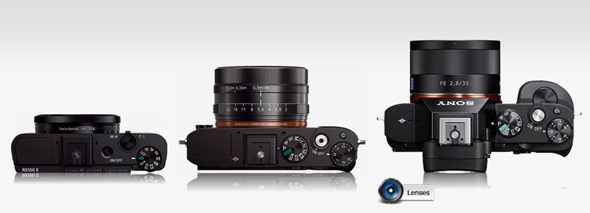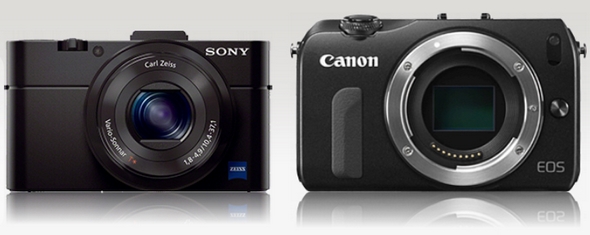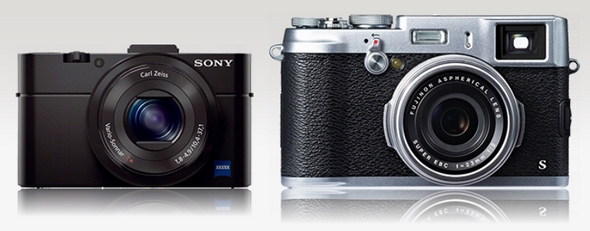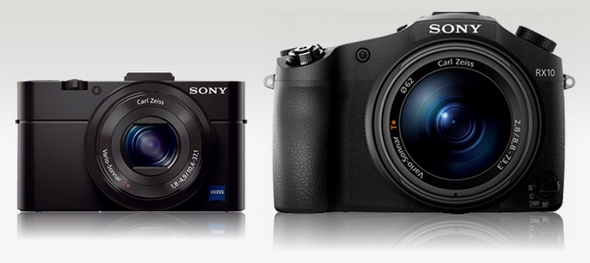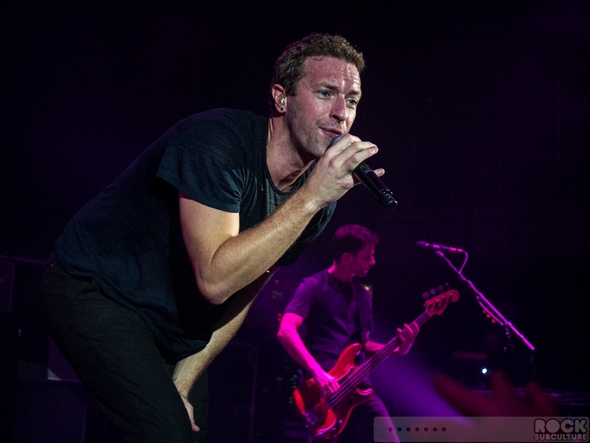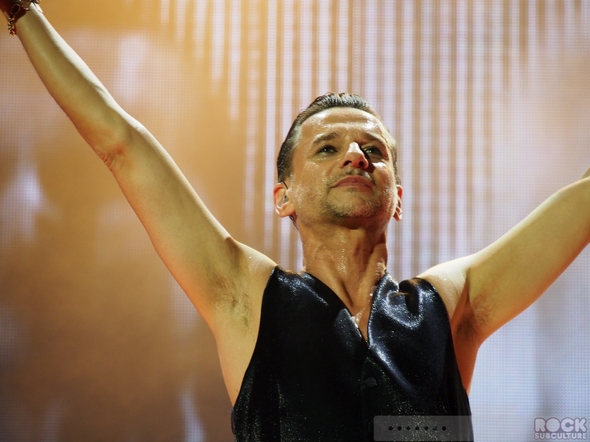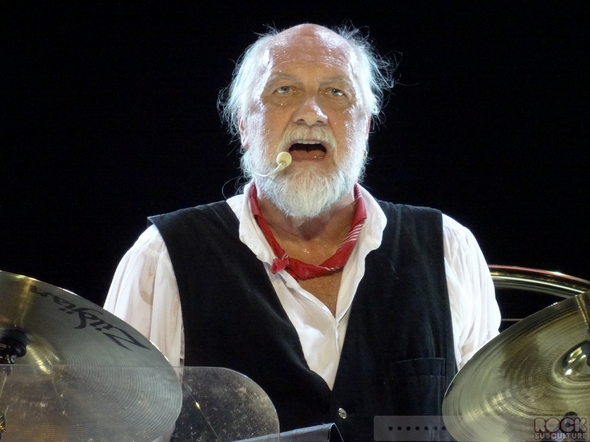As I’ve published the periodic article with recommendations and discussions about cameras for fan photography at music concert events, which seem to be fairly popular, I know with changing technology it is long overdue for an update. With this feature, I thought I would provide a broader overview with my own observations and experiences shooting with a variety of cameras and formats, including full frame, APS-C, micro four thirds, and smaller sensor cameras, spanning full-featured DSLRs, mirrorless, and point and shoot cameras. With this article, I will also provide some advice on general settings and shooting tips and tricks. Overall, I discuss options for cameras from shooting up close right in front of the stage as well as at a distance, for both still photos and video. In short, I’m still a huge fan of the Sony RX100, a year later, and feel it is the best overall “go to” option for fans – great image quality and truly pocketable.
My past articles on this topic can be found via the links below (which include a lot of great discussion via “Reader Comments” following each article):
I will talk a bit about specific camera models in each of the sections below, but keep in mind that things change very quickly with cameras, new models, and new technology, so if you have any questions feel free to post a “Reader Comment” at the bottom and I’m happy to provide a reply.
I’ve also provided links to each camera as listed on Amazon – if you purchase using these links I may receive a small commission, but either way it won’t affect the price charged to the buyer. You can also search for cameras through this link directly:
By way of background, in the event you find this article via Google and don’t know my background, this website is designed to publish my own concert reviews and photography, and probably 9 times out of 10 I have press credentials and shoot shows using my pro gear with permission from the artist and their management.
For a variety of reasons, sometimes that is not always possible, so I am at times held to the same restrictions as any fan attending a concert, so I am always staying abreast of the latest and greatest in photography so that I can take the best possible photos under any circumstances.
Every venue is different, and every show is different, so those restrictions are not based on hard and fast rules. However, the typical policy at concerts these days is framed as “no pro cameras”, “no cameras with detachable lenses”, or both.
However, I’ve also been to shows where venue personnel actually have fans power up their cameras and measure the length of the lenses at the longest zoom, prohibiting anything longer than three inches.
Obviously, the lines are blurred more and more every day, as there are small sensor point and shoot cameras today that can take photos nearly as well as some older pro cameras, depending upon how far away you are from the stage.
As an example, some times as a pro, I am asked to shoot from “front of house” or “sound board”, which can be very, very far from the stage. Even with a pro 300mm lens, someone standing in front of the stage could get better photos with an iPhone.
So everything is relative, and there are many conditions which can affect the quality of your photos, in addition to your equipment… Distance from subject, lighting (quality and color), movement, etc.
There is also the periodic show where NO photography is allowed, even from cell phones.
My advice is to learn the camera policy of a show, if you can, in advance of going to the venue. Oftentimes the venue isn’t told until day of, but better to ask and have some idea than be surprised at the door and have to deal with the prospect of losing your place in line or having no where to put your camera.
I attended nearly 100 concerts in 2013 alone, and I’ve seen it all… I’ve seen fans get into shows with full DSLRs with multiple detachable lenses, no problem. I had a fan standing next to me shooting with a $15,000 Leica set up. I’ve been to shows where no photography was allowed at all. Anything is possible.
So with these sections, I will start with the highest quality gear (and generally most expensive) and work my way down to point and shoot options.
This is not a technical article, and there are many sites on the net which provide technical and scientific analysis… So if that is the type of information that you are looking for, I’m not equipped to provide that to you, and I am a reader and fan of such sites myself (www.the-digital-picture.com, www.dpreview.com, www.imaging-resource.com, www.steves-digicams.com, www.fredmiranda.com, www.luminous-landscape.com, www.dxomark.com, www.photography-on-the.net, www.thephoblographer.com, www.canonrumors.com, and many, many, many others).
This is more of a real world and very subjective, non-technical primer based on my own personal experiences shooting photos at concerts using a wide variety of gear under many different circumstances.
Additionally, cameras that may work great under certain conditions can be useless in the very challenging conditions that can be found at music concerts.
To provide a bit of a visual about camera sensor sizes, I’ve made the graphic below which gives you an approximate idea of the size of different styles of sensors, and how they relate to one another (in short, the bigger the sensor, the better quality image and the less light that is needed for that image):

My Views on Fan Concert Photography
This is borrowed from my last article on this topic…
Everyone has opinions about music concerts and what people should or shouldn’t do at shows. I have a few personal thoughts about this, but my intent isn’t to create a debate or ever persuade people who may disagree to come around to my way of thinking, but merely to share my point of view to explain my purpose in creating this article and resource.
I started going to concerts in the late 80s, and the rules were always “NO CAMERAS”. Some of my fondest memories from growing up are my experiences going to concerts put on by my favorite artists, and apart from some ticket stubs and concert t-shirts, I don’t have much else to show for it. It was a different time, a different era, and there just aren’t many photos from those times, let alone the specific shows I personally attended, which in my opinion is unfortunate.
Fast forward to today, and technology has pretty much overrun any wishes by artists/record labels/venues may have in controlling photos taken at concerts. Once cameras started getting embedded into cell phones, it was a game changer, and there was no turning back. This in turn resulted in “pocket cameras” being allowed, and in the past few years, advances have been made that make it possible for literally anyone to take some fairly good quality photos from the audience.
I think this is wonderful on balance. I think of myself as a “gig archivist” though my objective is to memorialize the full experience with both words and quality images.
Having said all that, one counter point that I do agree with and have sympathy with are those who complain about people taking video and shooting photos that detracts from the enjoyment of the show for those around the person using a camera or phone.
There is nothing more annoying than going to the time and expense to attend a concert only to be stuck behind someone holding their phone or camera up in the air and blocking your view for a good portion of the show.
So I think it’s important to exercise good sense, common courtesy, and the Golden Rule. If you are going to take photos/video, you should really be mindful of how your actions impact those around you… keep your camera eye level (or lower), rear LCD (if there is one) dimmed down to its lowest level, etc. An occasional “pop up” with the camera is okay, but nothing more than that. If you can’t see and/or want to take a lot of photos, get in line early (if it is a GA show) to get to the front row or pay for a front row seat if its seated, so as not to affect other people and their enjoyment of the show.
Discretion and courtesy goes a long way!
Just my opinions…
The Concert Camera “Holy Grail” of Specs
So what is it that would make the perfect camera for concerts?
- Compact (preferably fitting in a jeans pocket)
- Largest sensor possible (full frame is best, then APS-C, then Micro Four Thirds, then 1″, then smaller)
- Widest and longest zoom range possible (the dream lens would be quality at 16mm to 500mm)
- Fastest lens possible (widest aperture is the smallest number, i.e. f/1.2 is wider/larger than f/5.6)
Is there a full frame, jean pocket, fixed lens camera that shoots f/1.8 from 16mm to 500mm? No, nothing close. It does not exist.
In reality, there are trade-offs. The better the quality – the larger the sensor, the longer the zoom, the faster the lens – the bigger the camera. Which is why larger pro DSLRs with large lenses take much better photos than the camera found in your cell phone.
But as technology improves, we get better and better cameras in smaller packages…
In other words, every year brings us to the holy grail, but we are still a decade or more from that dream camera actually existing for the mainstream and being affordable.
Full Frame Cameras
Until 2013, the only real options for full frame cameras were those full DSLR pro and semi-pro cameras made by companies like Canon and Nikon, with the exception of Leica, whose rangefinder-style cameras range in cost from around $5,500 for the Leica M-E to $8,000 for the Monochrome (with the CCD M9 and newer CMOS M 240 falling in-between), and some lenses cost even more than the bodies. There are an option, but are very expensive and I’ve had no experience shooting with them. Additionally, Leica cameras are range finders and there is no autofocus, only manual focus, which makes them more challenging to use in concert situations (for the average fan, anyway).
Sony RX1 / RX1R
Early last year, Sony changed everything with their mirrorless Sony RX1, which features a full-frame camera with a fixed f/2.0 Zeiss lens. Since full frame cameras had heretofore been considered “pro” and fixed lens cameras were always considered non-pro, this one further blurred those already imperfect boundaries.
With the very high quality lens and 24 megapixel full frame sensor (Sony also provides similar high quality sensors to Nikon for their best pro cameras), this small compact camera can take photos that can be of the same quality as those shot with “pro” DSLRs.
However, while compact, it is not quite “pocketable”. A large coat pocket, yes, but certainly not a jeans front pocket, as the lens protrudes too far from the body.
One of my favorite cameras – which I’ll reference throughout this article – is Sony’s RX100. It has a 1″ sensor and is a camera that I provided high recommendations for in the past. As a point of reference, I will be using it as a model to compare sizes with other cameras under discussion in this article. The Sony RX100 is truly “jeans pocketable”. Also check out the recent article by Rob Reid on Boing Boing about this camera…
So below are two angles showing the Sony RX100 and Sony RX1 to give an idea of size and comparison (you can do your own size comparisons at www.camerasize.com):
Keep in mind the Sony RX100 is very, very tiny, so apart from the lens, the RX1 is very small, and would otherwise be (jeans) pocketable. But with the fixed lens, it is not.
Not long after the release of the Sony RX1, Sony put out the Sony RX1R, which is the same camera, only it is missing the anti-aliasing filter.
The AA filter reduces aliasing, which is the rainbow-like moiré patterning that appears in some photos (typically if there are fine parallel lines). When removed, the images are subject to those moiré patterns, but you also gain more detail in your images. So it is a trade-off, which is why Sony continues to offer both models (and at the same price, $2,799).
Because the camera is fixed at 35mm, it is really only useful if you are in the front row (and near the center) at a concert. Otherwise you are getting the backs of fans’ heads and arms, and your subjects aren’t going to fill the frame appropriately. Though, with a full frame sensor and 24 megapixels, it does allow some ability to crop your image down to something more ideal and useful.
I had an opportunity to shoot the Sony RX1R at a Depeche Mode concert at The Palms in Las Vegas last year, and I was quite impressed with the results. It was relatively fast to focus and could fire off a lot of frames before slowing down due to the buffer being filled. That venue has a wide stage though, so even though I was in the front row, though off to one side, 35mm really didn’t cut it. I cropped many of my images, even from the front row shooting perspective.
The RX1 and RX1R offer an in-camera crop, so a sort of digital zoom, but it drastically reduced the speed of the camera and sequential shooting, so it was pretty much useless. The speed was gone.
If you tend to see shows in small, club-like venues with a low stage, no security/photo pit, and you tend to be right up front, I would say it is the perfect camera for that scenario. But it is very expensive compared with other cameras that compete in this style and focal length range (i.e. Fuji X100S, Ricoh GR, etc.)
If you go to arenas for concerts, unless you like shots of crowds, it is not a good choice.
Here is a short list of pros and cons for the Sony RX1 and RX1R…
Sony RX1/RX1R Pros:
- Top notch image quality
- Small and compact
- Technically a “Point and Shoot”, so should be allowed into concerts under those guidelines
Sony RX1/RX1R Cons:
- Expensive at $2,799
- Small, but not small enough to fit in your jeans pocket
- Fixed 35mm lens is very limiting
- No upgrade path – lenses tend to hold value while value of bodies drop – here your lens is stuck on a camera that will be improved upon
- No built-in viewfinder, and though you can buy one, it is expensive ($450) and adds bulk to the top of the camera
- Appears “pro-like”, so chance you would be stopped at the door of a concert venue
Sony A7 / A7R
In few months, Sony released two versions of their new full frame mirrorless camera platform that has interchangeable lenses – the Sony A7 and A7R.
As with the RX1 and RX1R, the “R” version of the A7 has no AA filter, as well as a higher megapixel sensor (24 megapixel on the A7 vs 36 megapixel on the A7R).
I was intrigued by the possibilities, but the A7 is even larger than the RX1, as it has a built-in viewfinder.
There are few lenses offered by Sony (two big zooms and a 35mm and 50mm), but it has the ability to use lenses from other manufacturers with adapters… but then you are in many cases focusing manually (like with the expensive Leica mount lenses).
The 35mm lens that is shipping with these is f/2.8, which is slower than the f/2.0 lens build into the RX1 bodies, so not as good.
I have not shot with one of these, but given what I have read about them, I would not recommend them for concert photography by fans, shooting from the crowd. At this time, anyway.
Since the A7 ($1,700) and A7R ($2,300) are using lenses that are close to the same size as full DSLRs use, and they are interchangeable bodies, I think most concert venues would not allow someone to enter the venue with them.
To give an idea of size, below is the comparison between the Sony RX100, the RX1, and the A7 (the latter with the smallest native lens available, the 35mm 2.8):
I like that Sony is going in this direction, but I would take a wait and see approach and see how the new format matures before investing in it, even if you could bring them into a show as a fan.
Sony A7/A7R Pros:
- Top notch image quality
- Ability to use an incredible number of lenses
Sony A7/A7R Cons:
- Expensive at $1,700 and $2,300 for body-only
- Very few native lenses designed for the system (and they are very expensive)
- Most interchangeable lenses are large
- Interchangeable lenses could prove problematic bringing into concert venues
Apart from DSLRs and options from Leica, I feel the only really feasible full frame option for fans to bring into concerts at this time is the Sony RX1 or RX1R, if you can get past the price ($2,799) and plan to be up close frequently enough (or for an important enough show) to make it worthwhile.
Having said all that, there are other options worth exploring, as I will get into below.
APS-C Sensor Cameras
Many consumer-oriented and even pro-oriented cameras feature the APS-C sensor. The full Canon “Rebel” line and many Nikon cameras feature APS-C sensors.
I do periodically see fans gain entry into shows with APS-C DSLRs, but I would not count on that happening, personally.
There are some interchangeable lens options that are small, but due to the size of the APS-C sensor, the lenses tend to be fairly large as well, sometimes as large as the lenses designed for full frame DSLRs. So this is not a great option, and I will not spend much time here going into those cameras, as there is too much downside.
Canon EOS-M
Canon actually released a mirrorless APS-C camera that uses interchangeable lenses (including a discreet “pancake” lens), but it was pretty much a total flop. The Canon EOS-M. Which is why I bought one, as many retailers cleared them out for three hundred dollars, including the 22mm pancake lens.
The Canon EOS-M, with the 22mm pancake lens attached, looks like a point and shoot, so it is relatively easy to bring into a show.
It can take good photos, but I found that it does not focus well at all in concert lighting conditions (too little light and/or light changing too quickly), and with the 22mm lens (which is equivalent to 35mm in the full frame format – 22mm x 1.6 crop factor), the same limitations as I explained above with the Sony RX1 (with its fixed 35mm lens).
It is a cheap alternative, but it will fight you in a concert. One benefit, however, is that the rear LCD is a touch screen, so you can touch to focus and fire the shutter as well. I’ve just found that spot exposure does not seem to work very well with this camera.
If you can still find it cheap, with the pancake lens, I would say it is a good deal shooting under the same conditions I described for the Sony RX1 (front row, close to center). When these were cleared out, I picked up the EOS-M with the 22mm pancake lens for $299.
The EOS-M can use other Canon lenses, but you have to buy an adapter, and then it looks “pro” and then you have problems bringing it into shows.
I have brought it into shows, and sometimes I’ve gotten great results, other times it has proven useless, so it is hit and miss depending on the circumstances. It is best from front row center, with perfect lighting, and subjects that don’t move very much.
Below is the comparison between the Sony RX100 and the Canon EOS-M (the latter with the smallest native lens available, the 22mm pancake):
Canon EOS-M Pros:
- Great image quality
- Small, pocketable, and discreet
- Cheap (around $300 including 22mm pancake lens)
Canon EOS-M Cons:
- Only viable interchangeable lens is 35mm equivalent
- Struggles in concert lighting conditions
- Spot exposure doesn’t work reliably in concert situations
- No built-in viewfinder
- Interchangeable lenses could prove problematic bringing into concert venues
Fuji Finepix X100s
My past articles talked about Fuji’s X100 and X100s. These are APS-C cameras with 35mm equivalent fixed lenses (much the same as the Sony RX1 and RX1R).
One of the best things about the Fuji X100 and X100s are that they have dedicated dials for both aperture and shutter speed, which is awesome. A joy to use.
The X100s vastly improves on the X100, so I would only recommend the former at this point. The Fuji X100s retails for $1,299. Fuji just announced an all-black version (which is much more discreet, in my opinion), which will be out in about a month.
The X100s takes amazing photos and does very well now with burst/consecutive shooting.
The Pros and Cons are pretty much the same as what I listed for the Sony RX1 and RX1R, only the Fuji X100s is less than half the price, and includes a fantastic viewfinder (which can switch between optical and electronic), so it offers a much better value proposition. The Fuji X100s also has a silent/leaf shutter mode, so can be extremely discreet.
In my opinion, the Fuji X100s bests the Sony RX1 and RX1R in all areas other than pure image quality and video (the Fuji X100s isn’t recommended for video).
You can technically fit it in a jeans pocket, but the lens will show a noticeable bulge.
Below is the comparison between the Sony RX100 and the Fuji X100s:
Fuji X100s Pros:
- Great image quality
- Small, nearly jeans pocket pocketable, and discreet
- Excellent low light capability
- Top of class controls, with dedicated shutter speed and aperture dials
- Excellent optical and electronic viewfinder
Fuji X100s Cons:
- Fixed 35mm equivalent lens is limiting
- No upgrade path – lenses tend to hold value while value of bodies drop – here your lens is stuck on a camera that will be improved upon
- Medium battery life
Ricoh GR
This is a very popular 16 megapixel APS-C camera that is super compact and popular among many street photographers. It has a 28mm equivalent f/2.8 lens.
It is cheaper than comparable cameras at $799.
I did try one and personally hated it – it felt cheap and slow, and in low light the results were very grainy. Plus 28mm vs 35mm is even wider, making it less useful in concert conditions. I wouldn’t recommend it, but I’m sure others will disagree.
Below is the comparison between the Sony RX100 and the Ricoh GR:
Model Pros:
- Good value for price, compared with competing 35mm fixed lens APS-C cameras
- Extremely compact – jeans pocket pocketable, and discreet
- Excellent low light capability
- Dedicated, highly customizable dials
Model Cons:
- Fixed 28mm equivalent lens is limiting and too wide
- Poor low light capability
- No built-in electronic viewfinder
- No upgrade path – lenses tend to hold value while value of bodies drop – here your lens is stuck on a camera that will be improved upon
- Medium battery life
Micro Four Thirds Cameras
Micro Four Thirds is a standard for cameras with a sensor that is a bit smaller than APS-C. These also feature interchangeable lenses. While the sensor is smaller, the benefit is that the interchangeable lenses are much, much smaller than lenses made for interchangeable lens APS-C and Full Frame cameras (with the exception of Leica).
In 2013, I tried out two bodies and a handful of lenses – the Olympus OM-D EM-5 and the Panasonic Lumix DMC-GX7.
In terms of shooting at a concert, I didn’t find the overall differences between them to be significant enough to warrant two separate write-ups below, so I will talk about them more generically as an overall format, as well as comparing and contrasting between the two to highlight the differences.
Olympus OM-D EM-5 and Panasonic Lumix DMC-GX7
The image quality from these Micro Four Thirds cameras is actually quite good in everyday conditions, but being used to shooting with full frame pro cameras for the most part, I found that in challenging lighting conditions the images were a bit more grainy than I prefer.
Part of the trade-off with this proposition is that the smaller, more discreet lens options tends to be slower, while the lenses that perform better (with wider apertures) are bigger, and defeat the purpose of going to this option for concert photography.
I also found that at times they would struggle with focusing in concert situations.
And, as interchangeable lens cameras, though small, they could still be barred from entry into concerts, so there is that element of risk to the overall proposition, and I don’t feel that the gains in image performance outweigh that risk (though I personally had no problems bringing them into shows).
All in all, they are one of the better options to shoot from further back from the stage and still get adequate image quality.
The most compact, light weight telephoto zoom option for the format is the Panasonic H-FS45150K Lumix G Series Lens, which is a 45mm-150mm zoom lens, but the Micro Four Thirds format has a 2X crop factor, so in the 35mm world, it is a 90mm-300mm equivalent. And the lens is less than 3″ long when contracted.
There are also a number of fast, wide, pancake-sized lenses that, when attached, make most of the Micro Four Thirds cameras look like point and shoots.
Between the two models I tried, the OM-D EM-5 is much bigger with the “hump” of it’s built-in viewfinder, while the GX7 has a viewfinder off to the side, which also tilts up. The newer, more pro-oriented iteration of the former, the new Olympus OM-D EM-1, is very popular, earning “Camera of the Year” accolades from proponents of smaller form factor cameras, like Steve Huff. The EM-1 is even bigger than the EM-5, and to me, it “looks” like a DSLR, and I think people could therefore run into issues bringing one into concerts.
Below is the comparison between the Sony RX100 and the Olympus OM-D EM-5 (the latter with the small 20mm pancake lens):
Below is the comparison between the Sony RX100 and the Panasonic GX7 (the latter with the small 20mm pancake lens):
Model Pros:
- Good value for price, compared with competing Full Frame and APS-C cameras
- Extremely compact, varying depending on which model and lenses
- Built-in electronic viewfinder
- Some interchangeable lenses are small
Model Cons:
- In concert conditions, image quality not as good as Full Frame and APS-C cameras
- Interchangeable lenses could prove problematic bringing into concert venues
Point & Shoot Cameras
This is the option that most concert fans will turn to, and in many cases, the image quality will be good enough and there will be no issues bringing into a concert event, and they are typically much more economical.
I wrote in some detail about my favorite point and shoot cameras in my past articles, some of which I will republish below. All of my favorites are by Sony.
Since that last article, Sony released two new cameras that factor into this discussion, the RX100II (and update to my favorite, the RX100) and the RX10, which has the RX100II sensor but a faster lens throughout and longer zoom.
The new Sony RX10, which I have not tried hands on, has a max aperture of f/2.8 throughout it’s long range of 24mm-200mm. The trade-off is that it is much, much bigger than the truly pocketable RX100 and RX100II.
The Sony RX10 actually “looks” like a DSLR, even though it has a fixed lens. It is also much more expensive than the RX100 ($548) and RX100II ($698), coming in at $1,298. Even though the Sony RX10 does not break the typical concert venue rules, when on and zoomed the lenses is very, very long, and just the looks of it might cause issues.
As I’ve mentioned in the discussion within the Reader Comments of my last article, the Sony HX50V, which replaced the Sony HX20V that I wrote about in the article, has been a disappointment to me. I loved the Sony HX20V, with it’s 20X zoom featuring a 25-500mm range, compared with the newer Sony HX50V, with a 30X zoom equivalent of 24mm-720mm. I’ve just felt that the newer HX50V sensor is awful in low light, and inferior to the older HX20V and it’s older sensor. The HX20V is long out of circulation, but I would recommend tracking it down over the HX50V, which is now selling for only $340.
My summary from my article in February 2013, funny enough, hasn’t changed to much in the past 11 months, so I have copied it below:
I am recommending three cameras because each excels in certain areas and falls short in others. Believe it or not, if I don’t have a photo pass, I actually bring all three of these cameras in myself, as each serves a unique purpose.
In short, the Sony HX20V is the best if you are not within the first few rows of the stage. The zoom allows you to get close-up photos from a significant distance. The Sony RX100 is much better quality and you can get more shots off and freeze some action, but it is limited to 100mm reach vs 500mm equivalent with the HX20V. The image quality of the Fuji X100 is unsurpassed compared with any other camera a regular concert goer can bring into a venue with little problem, but since it is fixed at 35mm (no zoom whatsoever), it is really only useful if you are literally in the front row.
My updates to this are minor… I would still recommend the Sony HX20V, in you can find it – otherwise, I would wait for the next iteration (or fall back to the Sony HX50V).
I still love the Sony RX100, but if you don’t have it, the Sony RX100II is probably a bit better all around (though it is slightly bigger due to the tilting rear LCD screen).
I’m still a fan of the Fuji X100, but would absolutely recommend the newer Fuji X100s instead, as it fixed nearly everything that wasn’t perfect about the original.
I would also suggest taking a look at the newer Sony RX10. In terms of performance, it is a dream (on paper at least); the only negatives being the large size and price.
Below is the comparison between the Sony RX100 and the Sony RX10:
In terms of video, the Sony HX9V, Sony HX20V/30V, Sony HX50V, Sony RX100, Sony RX100II, and Sony RX10 are all awesome, the main differences being the zoom range. I would recommend all of them.
Sony HX20V/30V and Sony HX50V
These are the best all-around, on solution, (relatively) cheap cameras.
Model Pros:
- Small and light; compact (easily fits in a front jeans pocket)
- Long reach/zoom – 20X (25mm to 500mm equivalent in 35mm spec) for HX20V and 30X (24mm to 720mm equivalent)
- Fast zoom
- Excellent Video (and excellent sound shooting video)
- Moderate battery life
Model Cons:
- Designed for one shot at a time (no quality continuous shooting)
- Moderate image quality
- Poor low light capability
- Relatively “slow” lens (maximum aperture of f/3.2)
- Not great still camera for action (movement from photographer and/or subject results in blur)
Sony RX100 and Sony RX100II
In my opinion, these are the very best, one camera solution – great quality, compact size, reasonable price – only drawback is you have a maximum reach of 100mm.
Model Pros:
- Small and light; compact (easily fits in a front jeans pocket)
- Moderate reach/zoom – 3.6X (28mm to 100mm equivalent in 35mm spec)
- “Fast” quality lens with large aperture at widest focal length (f/1.8-4.9 Carl Zeiss Lens)
- High quality images with large 1″ sensor
- High quality burst shooting (up to 10fps continuous shooting)
- Moderate still camera for action (much better than HX20V in freezing action, but results still mixed depending on lighting/settings/movement)
- Excellent video (and excellent sound shooting video – but slow zoom)
- Great battery life
Model Cons:
- Not very long reach compared with cheaper HX20V/HX30V and HX50V
- Widest aperture decreases as you zoom
- Slow zoom (Stills and Video)
Sony RX10
As mentioned, I have not used this, but read a lot about it and can draw some conclusions based on my use of the Sony RX100.
Model Pros:
- Great zoom range
- “Fast” quality lens with large aperture at throughout focal length (f/2.8 Carl Zeiss Lens)
- High quality images with large 1″ sensor
- High quality burst shooting
- Moderate still camera for action
- Excellent video (and excellent sound shooting video)
- Good battery life
Model Cons:
- Very, very, very large
An Important Note About Camera Settings – “Spot Metering”
I’m putting this up and center because being mindful of these suggestions will result in better photos and more “keepers” no matter what camera you use.
The most important setting to look for with your camera is “Spot Metering”. Not every camera will have it, but each of the three cameras discussed in this article have this option.
This is very important in concert photography due to the extreme lighting usually employed.
If you shoot on the equivalent of “Auto/Automatic” mode on your camera, it will usually evaluate the lighting in the full frame to determine exposure. Because it can be an extreme of black and very bright, often the subject’s face will be to white/bright (i.e. over exposed).
If you have an alternate mode in your camera that gives you the ability to use Spot Metering, I would highly recommend you find the mode you understand and are most comfortable using that has a Spot Metering option.
With Spot Metering employed, the camera will typically feature a circle in the center of your rear LCD and/or viewfinder… what you need to do when shooting is place this circle on your subject’s skin (i.e. their face) and press the shutter button down halfway to lock the exposure, then (while still holding the shutter button down halfway), you can “recompose” (or reframe) your subject and then press the shutter button down fully. The image will then expose the image based on your subject, not the full image, and the results will be much, much better.
Example Settings: Sony RX100 Camera Settings for Concerts
Mode – “S” (with shutter speed at 1/250 or 1/320 depending on how much action is on stage)
Photo Settings:
- Image Size – L:20M
- Aspect Ratio – 3:2
- Quality – Fine
- Drive Mode – Cont. Shooting
- Flash Mode – Flash Off (make sure this is off so you don’t flash at subjects, which is distracting/annoying for them)
- Focus Mode – Single-shot AF
- Autofocus Area – Spot
- Smile/Face Detect. – On
- ISO – ISO Auto
- Metering Mode – Spot
- Flash Comp. +0.0
- DRO/Auto HDR – D-Range Opt.
- Creative Style – Standard
- Picture Effect – Off
- Clear Image Zoom – On
- Digital Zoom – On (when shooting there is a line marking between optical and digital zoom, and I don’t pass that line, but keep “On” just in case)
- High ISO NR – Normal
- AF Illuminator – Off (make sure this is off so you don’t bounce distracting/annoying lights off the subjects)
- SteadyShot – On
- Color Space – sRGB
Video Settings:
- File Format – AVCHD
- Record Setting – 60p 28M(PS)
- Image Size (Dual Rec) – L:17M
- SteadyShot – Active
- Audio Recording – On
- Wind Noise Reduct. – Off
Additional Settings:
- Red Eye Reduction – Off
- Grid Line – Off
- Auto Review – 2 Sec
- Peaking Level – Off
- Control Ring – Standard
- Control Ring Display – On
- Func. of Center Button – Standard
- Func. of Left Button – Drive Mode
- Func. of Right Button – Flash Mode
- MF Assist – On
- Focus Magnif. Time – 2 Sec
- Face Priority Tracking – On
- Face Registration – –
Concert Camera Image Samples
Below are some photos I’ve personally taken using some of these cameras at shows I’ve attended… all photos were shot in camera as JPEGs and have not been altered apart from resizing for this article and including a watermark.
Sony RX1R (Full Frame) Samples
Sony RX1R (Full Frame) – f/2, 1/320 sec, ISO-1250, 35mm
Sony RX1R (Full Frame) – f/2, 1/400 sec, ISO-3200, 35mm
Sony RX1R (Full Frame) – f/4, 1/320 sec, ISO-3200, 35mm
Fuji X100 (APS-C) Samples:
Fuji X100 (APS-C) – f/2, 1/250 sec, ISO-640, 23mm (35mm equivalent – 1.6x crop factor)
Fuji X100 (APS-C) – f/2, 1/250 sec, ISO-400, 23mm (35mm equivalent – 1.6x crop factor)
Fuji X100 (APS-C) – f/2, 1/500 sec, ISO-500, 23mm (35mm equivalent – 1.6x crop factor)
Micro Four Thirds Samples
Panasonic GX7 (Micro Four Thirds) – f/4, 1/400 sec, ISO-3200, 45mm (90mm equivalent – 2x crop factor)
Panasonic GX7 (Micro Four Thirds) – f/5.6, 1/320 sec, ISO-3200, 150mm (300mm equivalent – 2x crop factor)
Olympus OM-D EM-5 (Micro Four Thirds) – f/6.3, 1/100 sec, ISO-1600, 150mm (300mm equivalent – 2x crop factor)
Fuji X100 (1″ Sensor) Samples
Sony RX100 (1″ Sensor) – f/1.8, 1/320 sec, ISO-1000, 10mm (27mm equivalent – 2.7x crop factor)
Sony RX100 (1″ Sensor) – f/1.8, 1/320 sec, ISO-400, 10mm (27mm equivalent – 2.7x crop factor)
Sony RX100 (1″ Sensor) – f/4.9, 1/100 sec, ISO-500, 34mm (92mm equivalent – 2.7x crop factor)
Sony HX50V (Small Sensor) Samples
Sony HX50V (less than 1″ sensor) – f/6.3, 1/125 sec, ISO-800, 72mm (401mm equivalent – 5.58x crop factor)
Sony HX50V (less than 1″ sensor) – f/6.3, 1/125 sec, ISO-1250, 63mm (351mm equivalent – 5.58x crop factor)
Sony HX50V (less than 1″ sensor) – f/6.3, 1/100 sec, ISO-800, 87mm (485mm equivalent – 5.58x crop factor)
~
If you have any questions, please post a “Reader Comment” below. I’m pretty good about replying same day, unless I am traveling.
Jason DeBord





